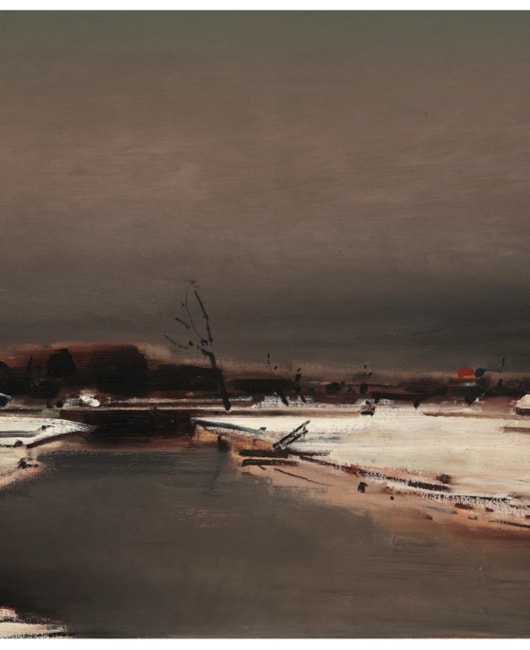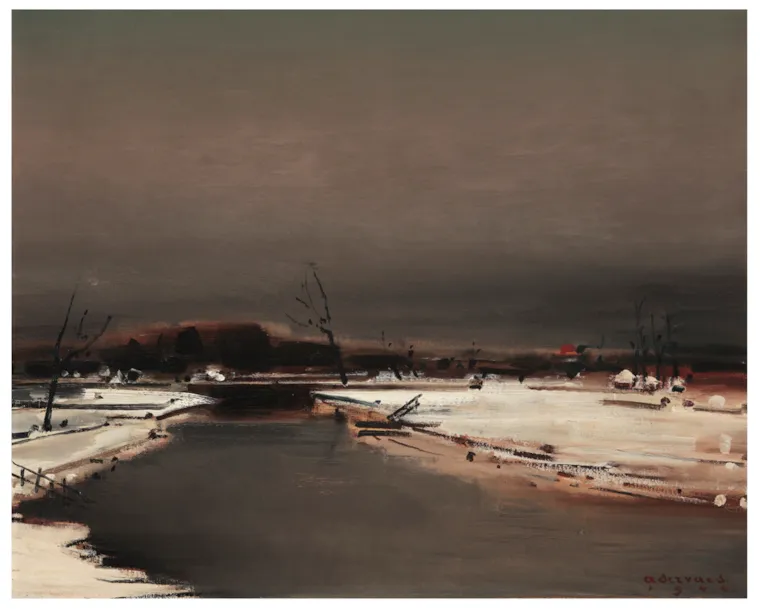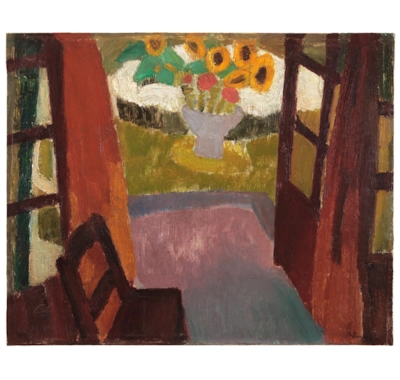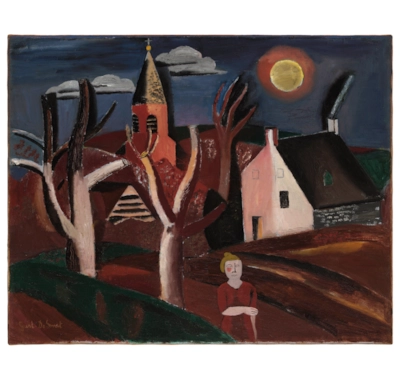Albert Servaes
(1883 - 1966)
The Leie in winter
1944
Oil on canvas
63 x 80 cm (24³/₄ x 31¹/₂ inches)
Framed: 86 x 102 cm
Signed lower right: a servaes / 1944.
Oil on canvas
63 x 80 cm (24³/₄ x 31¹/₂ inches)
Framed: 86 x 102 cm
Signed lower right: a servaes / 1944.
On the peaceful banks of the Leie in Sint-Martens-Latem Flemish expressionism came into being, as a powerful answer to the sunny luminism of Emile Claus and his countless followers. Alongside the subdued symbolism of Gustave Van de Woestyne and George Minne, Albert Servaes went in search of a penetrating interpretation of the worn-out Christian iconography from his wooden barracks. In powerful lines and simple compositions he gets to the essence of faith. Humility and compassion permeate his devout work. In addition to his deeply religious scenes, he boldly highlights the simple farmer, sowing and harvesting.
During the winter, the landsman remains in his farm and only chilly silence lies over the fields. With broad strokes Servaes brushes aside vast snowy landscapes in which defoliated trees and angular farmhouses appear motionless as black phantoms.
In 1920 he paints a religious life cycle, from birth to death, in twelve scenes. From a sunny yellow it slips into a wintry gray, with the final point being a melancholy funeral procession in pit winter. Later, he revisits various themes from the cycle in separate paintings. Always the gray snowy landscape remains the hushed backdrop for the passing. (F. Huygens)
During the winter, the landsman remains in his farm and only chilly silence lies over the fields. With broad strokes Servaes brushes aside vast snowy landscapes in which defoliated trees and angular farmhouses appear motionless as black phantoms.
In 1920 he paints a religious life cycle, from birth to death, in twelve scenes. From a sunny yellow it slips into a wintry gray, with the final point being a melancholy funeral procession in pit winter. Later, he revisits various themes from the cycle in separate paintings. Always the gray snowy landscape remains the hushed backdrop for the passing. (F. Huygens)
- Stubbe, A. "Albert Servaes en de eerste en tweede Latemse kunstenaarsgroep" in: Keurreeks van het Davidsfonds, no. 63 (Leuven: Davidsfonds, 1956).
- Boyens, P., Sint-Martens-Latem. Kunstenaarsdorp in Vlaanderen (Tielt: Lannoo, 1992), 295-309.
- De Smet, J., Sint-Martens-Latem en de Kunst aan de Leie (Tielt: Lannoo, 2000), 184-190.
- Haesaerts, P., Sint-Martens-Latem. Gezegend oord van de Vlaamse kunst (Brussels: Arcade, 1966), 202-231.
- Hoozee, R., D. Lampens, P. Baudson e.a., De eerste groep van Sint-Martens-Latem 1899-1914 (Brussels: KMSKB, 1988), 109-124.
- Schoonbaert, L.M.A., Albert Servaes (Tielt: Lannoo, 1984), 106-121, compare "Leielandschap" p. 111, 115.
- Storme, J., Albert Servaes, retrospectieve tentoonstelling, cat. (Bruges: Groeninge museum, 1961) (comparable painting).
- Boyens, P., Sint-Martens-Latem. Kunstenaarsdorp in Vlaanderen (Tielt: Lannoo, 1992), 295-309.
- De Smet, J., Sint-Martens-Latem en de Kunst aan de Leie (Tielt: Lannoo, 2000), 184-190.
- Haesaerts, P., Sint-Martens-Latem. Gezegend oord van de Vlaamse kunst (Brussels: Arcade, 1966), 202-231.
- Hoozee, R., D. Lampens, P. Baudson e.a., De eerste groep van Sint-Martens-Latem 1899-1914 (Brussels: KMSKB, 1988), 109-124.
- Schoonbaert, L.M.A., Albert Servaes (Tielt: Lannoo, 1984), 106-121, compare "Leielandschap" p. 111, 115.
- Storme, J., Albert Servaes, retrospectieve tentoonstelling, cat. (Bruges: Groeninge museum, 1961) (comparable painting).
You May Also Like
Albert Servaes
(1883 - 1966)
The Leie in winter








